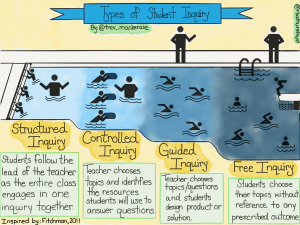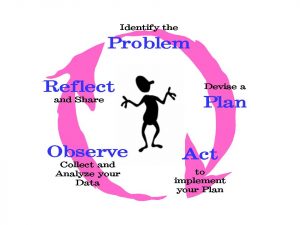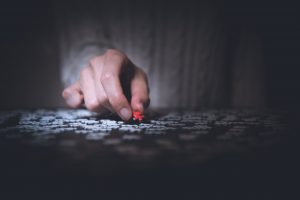 Photo by Ryoji Iwata on Unsplash
Photo by Ryoji Iwata on Unsplash
Introduction
When I consider a puzzle, each piece’s edge enables a connection. Some pieces may not physically fit together, because of their proximity. However, the completed puzzle represents interconnections, as each piece assists in creating the complete picture. As I reflect on EDCI 515 and 568, the areas I connected with, as a teacher-researcher, and which enabled me to complete a cognitive puzzle of knowledge, include: 1.) Educators use of social media as a form of communication with students; 2.) Decolonization practices; 3.) Student inquiry learning methods; and 4). Action research through the lens of the 4Rs, and how it can assist both the teacher-researcher in developing best practices, and learners as they explore inquiry learning.
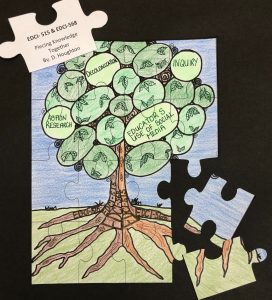
EDCI 515 & 568 Puzzle creation by D. Houghton
Educators Use of Social Media
Hearing of educators using social media, such as Twitter, to communicate with students, for educational purposes, initially, shocked me. My naivete and concern around ethics, regarding this style of communication, simply led me to believe it was wrong. However, upon reading the article by DeGroot et. al., I realize that there is a place for educators to use social media as a tool to communicate with learners. This article provides information outlining the perception of instructors’ credibility, for using Twitter as a means of communicating with college students. Arguments supported this style of communication, between instructor and students, and were seen as being beneficial for reasons, including: accessibility, information, improving instructor-student communication and relations, and student engagement. Initially, I was completely against this method of communication. However, the article brought up some valid points, and consequently, has pushed me, as the teacher-researcher, to consider creating a blog, or web-page, for my courses next year. Utilizing this method of communication with my students, will enable them to seek access to course specific material, dates, and other educational supports outside of the regular school times. Although the form of online communication I will be using is not as open as Twitter, it will provide accessibility and support to all students.
Decolonization Practices
I connected with Shauneen Pete’s class discussion and her narrative inquiry Meschachakanis, A Coyote Narrative: Decolonizing Higher Education, regarding the decolonizing of teaching methods and curriculum. I agree with Pete’s statement that “decolonization begins with naming colonial structures, then moving to re-frame, remake and reform them.” (Pete, 2018, p. 173) As a teacher-researcher, who teaches Social Studies, I feel it would be unethical, if I were to discuss and teach from only colonial perspectives, regarding the development of Canada. It is essential that students gain knowledge and understanding, of the colonization process, which led to the destruction, and dehumanization, of First Nations culture. Furthermore, I agree with Pete, that as educators, we must start making changes to curriculum and practices ourselves. It is no longer OK for educators to rely on First Nations individuals to do this teaching for us; it is our responsibility. It is time that educators take steps to, truthfully, illustrate the destruction, pain, distrust, and abuse of power, that colonial systems created, during the settlement process. It is simply not enough to invite a First Nations elder to one’s class to discuss a cultural issue, or historical wrong, and then move on. More learning and the educating of ourselves’, as teacher-researchers, must occur so we can educate our learners. As previously discussed in an earlier blog of mine, that focused on this topic, there are many ways teacher-researchers can incorporate decolonization methodologies into their teaching. Engaging students in inquiry projects that focus on Canada’s unethical treatment of our First Nations population, would enable learners to pick a specific topic that interests them, and dive deep to gain insight, knowledge, and understanding of why specific events occurred, and the horrific outcomes that resulted. By employing the research methodology of Action Research (which will be discussed later in this reflection), to complete an inquiry project, students will have the opportunity to question, gather information, reflect and continue this investigative, learning process, as they work to complete their project. Making changes to curriculum that supports decolonization, are steps that lead toward reconciliation, which are part of the Social Studies 10 curriculum outcomes.
Inquiry Process for Meaningful Learning and Personal Growth
Illustration by Trever MacKenzie
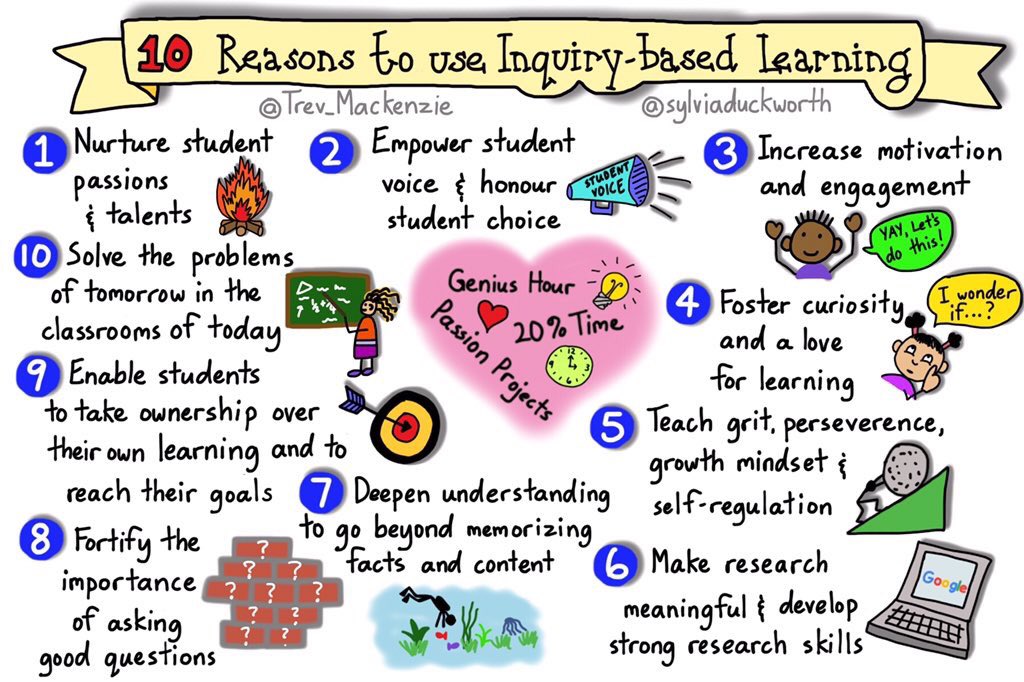
Teaching for Meaningful Learning, by Dr. Brigid Barron and Dr. Linda Darling- Hammond, the Most LikelyTo Succeed, film on High Tech High, and guest speakers, author Trever MacKenzie, and Jeff Hopkins from the Pacific School of Innovation and Inquiry, shared their knowledge of different types of inquiry methods and learning styles. As a teacher-researcher, I support this method of learning, as it enables students to explore their interests, and deepen their knowledge and understanding while focusing on a particular topic. The inquiry method of learning is an exciting process to watch unfold. As a teacher-researcher, you get to witness students’ discoveries, ownership, and pride in their learning. Furthermore, the method of inquiry learning supports the fact that not all students learn the same. Inquiry learning enables learners to utilize their strengths and unique skills to complete a project. There is so much more to teaching than simply reading the textbook to students or showing a video. The proponents, of inquiry-based learning, identify that this style, or method, of learning provides students with the opportunity to engage in different activities that cultivate their knowledge. This facilitates in their understanding of a concept, an idea, and/or their ability to answer in-depth questions. Trever Mackenzie, highlights various levels of inquiry educators and students can follow depending on where students skill levels are in completing an inquiry project.
The inquiry process enables learners to be creative, and facilitates investigation and collaboration amongst peers. Learners, for example, may engage in mock debates, choose to create music, artwork, digitally created models, and or a carefully constructed showpiece to demonstrate their knowledge. The process of inquiry is a far superior learning method, compared to sitting at a desk and simply answering questions. Lastly, this method of learning fosters the development of skills needed in life, including, but not limited to: problem solving, communication (reading, writing and speaking), commitment, time management, and organization.
Action Research Methodology in the Classroom
Getting To Grips With Perspectives And Models, as described by Mary McAteer, connected with me as a teacher-researcher in two ways; including the further development of my teaching practices, and as a guide my students could follow while completing an inquiry learning project. In terms of my teaching practices, I could employ this methodology (as the researcher) to document and examine my students’ progress (the researched), while completing the Social Studies 10 course. Action research would enable me to reflect upon where, and how, I need to improve my lessons, thereby improving student learning (the research). Myself, as the reader of the action research reflections, would be able to see where I need to make changes to lessons, then move through the action and reflection cycle again. In terms of students using action research as a guide to complete inquiry projects, they too could employ the cyclical steps of this methodology to carry out their process of inquiry learning. In this case, the students would be the researchers, who would plan and develop their inquiry question, which would lead their inquiry research. Students gathering of information, and building of knowledge, culminating in the answer to their inquiry question, would be the researched. Readers would be the students as they reflect back on their project, and then eventually me as a teacher-researcher, as part of my assessment. Employing the action research methodology to complete an inquiry project, enables students to plan, act, make observations of their learning, reflect on their progression, and continue the cycle process until the project is complete. (Illustration of Action Research Cycle, as shown below).
Conclusion
Although EDCI 515 and 568 were focused on different areas, in terms of course layout, they both had themes that were interconnecting, and fostered further development in understanding that I can utilize as an educator in my classes this coming school year. The four areas, as reflected on above, were the main concepts that resonated with me as a teacher-researcher. These areas, although they may have been taught separately, are interconnected as they share aspects, insight and knowledge. The four areas I connected with are significant to me, because they have broadened my mind, and provided me with knowledge and skills I can bring back to my classroom, to create a learning design, with the ultimate goal being to enhance my students’ learning experience and improving my teaching practices. My new learning design will include: online communication to my students, that is accessible to all, and provide course specific information; increased learning regarding decolonizing; the employment of inquiry learning and action research steps to facilitate and support learning. Connecting the puzzle pieces from EDCI 515 and 568, have provided me with a completed picture, as to what I want to develop, professionally, to assist my students in educational growth.

